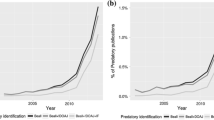Abstract
This article applies an economic model to analyze the supply and demand relationship of predatory journal publishing. It uses the quantity of journals and articles as the supply index and the number of researchers as the demand index, attempting to examine how the changes in their condition will influence an economic equilibrium. Instead of using price as the determinant of market balance, the article highlights the quality of publications as the measure. It suggests that an increase in open access journal publishing has overtaken the growth of researcher population worldwide. Particularly, the rapid and massive development of predatory journals, those that lack peer review but charge for article processing fees, has resulted in a decline in publication quality.


(Source: UNESCO http://data.uis.unesco.org/#)

(Source: Ulrich’s Web)

(Source: web.archive.org)

(Source: doaj.org)



Similar content being viewed by others
References
King DW. The cost of journal publishing: a literature review and commentary. Learn Publish. 2007;20(2):85–106. https://doi.org/10.1087/174148507X183551.
Page G, Campbell R, Meadows J. Journal publishing. Cambridge: Cambridge University Press; 1997.
Waltham M. JISC: learned society open access business models, 184. Princeton: MaryWaltham.com; 2005.
Callaos N. Costs, Prices and Revenues in Journal Publishing, 2011. http://www.iiisci.org/journal/sci/Costs.pdf. Accessed 17 May 2019.
Mehlum H. The case for open access publishing. Int Stud Perspect. 2012;13(3):216–23. https://doi.org/10.1111/j.1528-3585.2012.00490.x.
Van Noorden R. Open access: the true cost of science publishing. Nature. 2013;495:426–9. https://doi.org/10.1038/495426a.
Tennant JP, Waldner F, Jacques DC, Masuzzo P, Collister LB, Hartgerink CHJ. The academic, economic and societal impacts of open access: an evidence-based review. F1000Research. 2016;5:632. https://doi.org/10.12688/f1000research.8460.3.
Laakso M, Welling P, Bukvova H, Nyman L, Björk BC, Hedlund T. The development of open access journal publishing from 1993 to 2009. PLoS ONE. 2011;6(6):e20961. https://doi.org/10.1371/journal.pone.0020961.
Solomon DJ, Björk BC. A study of open access journals using article processing charges. J Am Soc Inf Sci Technol. 2012;63(8):1485–95.
Shen C, Björk BC. ‘Predatory’ open access: a longitudinal study of article volumes and market characteristics. BMC Med. 2015;13:230. https://doi.org/10.1186/s12916-015-0469-2.
Suber P. Ten challenges for open-access journals, SPARC Open Access Newsletter, 2 Oct 2009. https://dash.harvard.edu/handle/1/4316131. Accessed 17 May 2019.
Tin L, Ivana B, Biljana B, Ljubica IB, Dragan M, Dušan S. Predatory and fake scientific journals/publishers—a global outbreak with rising trend: a review. Geographica Pannonica. 2014;18(3):69–81.
Beall J. Predatory publishers are corrupting open access. Nature. 2012;489(7415):179. https://doi.org/10.1038/489179a.
Björk BC. Have the “mega-journals” reached the limits to growth? PeerJ. 2015;3:e981. https://doi.org/10.7717/peerj.981.
Xia J. Predatory journals and their article publishing charges. Learn Publish. 2015;28(1):69–74.
Basken P. Open-access publisher appears to have accepted fake paper from bogus center. The Chronicle of Higher Education, 10 Jun 2009. http://www.chronicle.com/article/Open-Access-Publisher-Appears/47717. Accessed 17 May 2019.
Bohannon J. Who’s afraid of peer review? Science. 2013;342(6154):60–5.
Sorokowski P, Kulczycki E, Sorokowska A, Pisanski K. Predatory journals recruit fake editor. Nature. 2017;543:481–3. https://doi.org/10.1038/543481a.
Kearney MH. Predatory publishing: what authors need to know. Res Nurs Health. 2015;38:1–3. https://doi.org/10.1002/nur.21640.
Xia J, Harmon JL, Connolly KG, Donnelly RM, Anderson MR, Howard HA. Who publishes in “predatory” journals? J Assoc Inf Sci Technol. 2014;66(7):1406–17. https://doi.org/10.1002/asi.23265.
Oermann MH, Nicoll LH, Chinn PL, Ashton KS, Conklin JL, Edie AH, Amarasekara S, Williams BL. Quality of articles published in predatory nursing journals. Nurs Outlook. 2018;66(1):4–10.
Xia J. An imbalanced journal publishing market. Learn Publish. 2014;27(3):236–8.
Marshall A. Principles of economics: an introductory volume. London: Macmillan and Co., Ltd; 1890.
Morris S. What’s so special about not-for-profit publishers? Learn Publish. 2001;14(3):163–5. https://doi.org/10.1087/095315101750240403.
Larivière V, Haustein S, Mongeon P. The oligopoly of academic publishers in the digital era. PLoS ONE. 2015;10(6):e0127502. https://doi.org/10.1371/journal.pone.0127502.
Frank M. Open but not free—publishing in the 21st century. Engl J Med. 2013;368:787–9. https://doi.org/10.1056/NEJMp1211259.
Garfield E. What is the primordial reference for the phrase ‘publish or perish’? The Scientist. 1996;10(12):11.
de Rond M, Miller AN. Publish or perish: bane or boon of academic life? J Manag Inq. 2005;14(4):321–9.
Denning PJ. Anew social contract for research. Commun ACM. 1997;40(2):132–4.
MOE (Ministry of Education of the People’s Republic of China). Statistics. http://www.moe.gov.cn/. Accessed 17 May 2019.
Wiryawan KG. The current status of science journals in Indonesia. Sci Edit. 2014;1(2):71–5.
Quan W, Chen B, Shu F. Publish or impoverish: an investigation of the monetary reward system of science in China (1999–2016). Aslib J Inf Manag. 2017;69(5):486–502. https://doi.org/10.1108/AJIM-01-2017-0014.
Padma TV. India: the fight to become a science superpower. Nature. 2015;521:144–7.
Nwagwu WE, Ojemeni O. Penetration of Nigerian predatory biomedical open access journals 2007–2012: a bibliometric study. Learn Publish. 2015;28(1):23–4.
Plume A, van Weijen D. Publish or perish: the rise of fractional author. Res Trends. 2014;38:16–8.
Ware M, Mabe M. The STEM report: an overview of scientific and scholarly journal publishing. The Hague: International Association of Scientific, Technical and Medical Publishers; 2015.
Buranyi S. Is the staggeringly profitable business of science publishing bad for science? The Guardian, 2017.
Scientific Publishing. The price information. The Economist, 4 Feb 2012. http://www.economist.com/node/21545974. Accessed 17 May 2019.
Xia J. An examination of two Indian megajournals. Learn Publish. 2014;27(3):195–200.
Flaherty C. Should grad students publish? The Chronicle of Higher Education, 2017.
Phys.com. China probes academic fraud by cancer researchers, 15 Jun 2017. https://phys.org/news/2017-06-china-probes-academic-fraud-cancer.html. Accessed 17 May 2019.
Björk BC, Solomon D. Article processing charges in OA journals: relationship between price and quality. Scientometrics. 2015;103(2):373–85.
Moed HF. The impact-factors debate: the ISI’s uses and limits. Nature. 2002;415:731–2. https://doi.org/10.1038/415731a.
Tyler T. Citation metrics and impact factors fail as measures of scientific quality, in particular in taxonomy, and are biased by biological discipline and by geographic and taxonomic factors. Annales Botanici Fennici. 2018;55(1–3):185–91. https://doi.org/10.5735/085.055.0123.
Author information
Authors and Affiliations
Corresponding author
Additional information
Publisher's Note
Springer Nature remains neutral with regard to jurisdictional claims in published maps and institutional affiliations.
Rights and permissions
About this article
Cite this article
Xia, J. Economic Modelling of Predatory Journal Publishing. Pub Res Q 35, 377–390 (2019). https://doi.org/10.1007/s12109-019-09661-9
Published:
Issue Date:
DOI: https://doi.org/10.1007/s12109-019-09661-9





